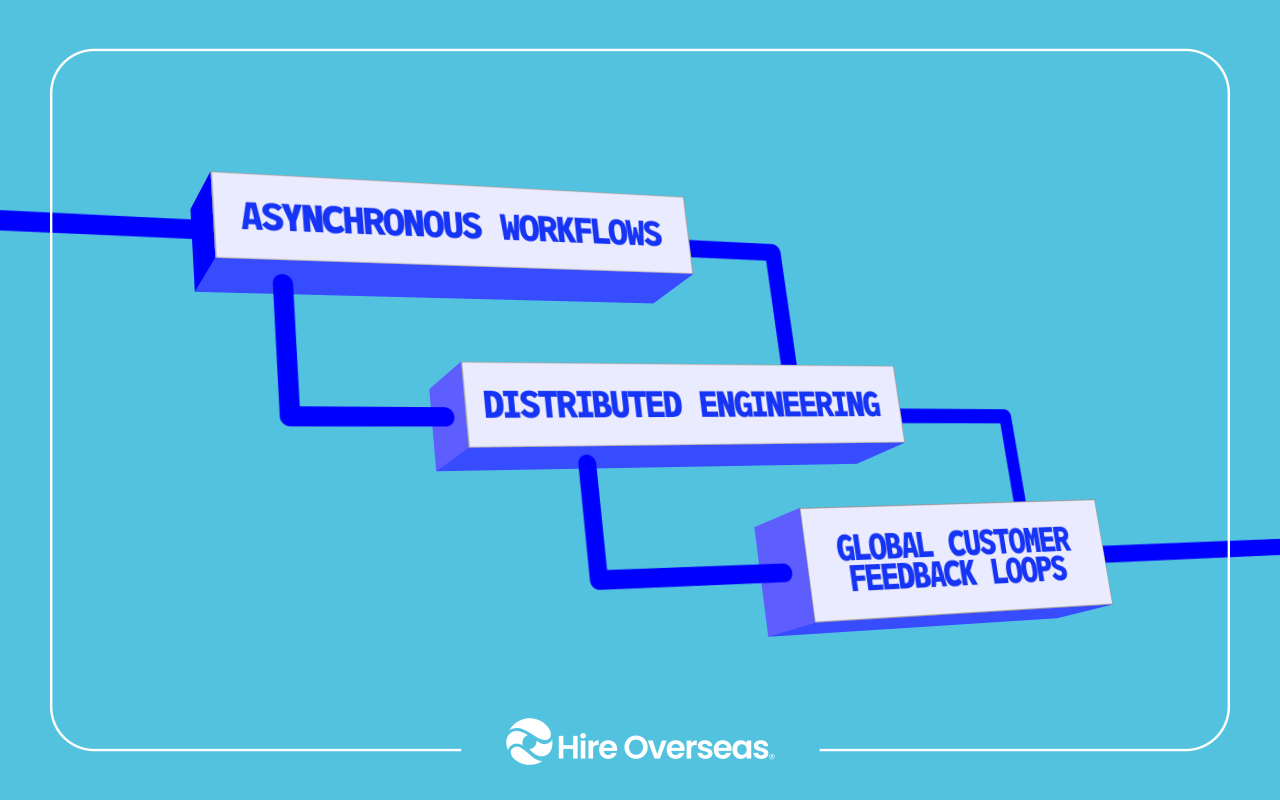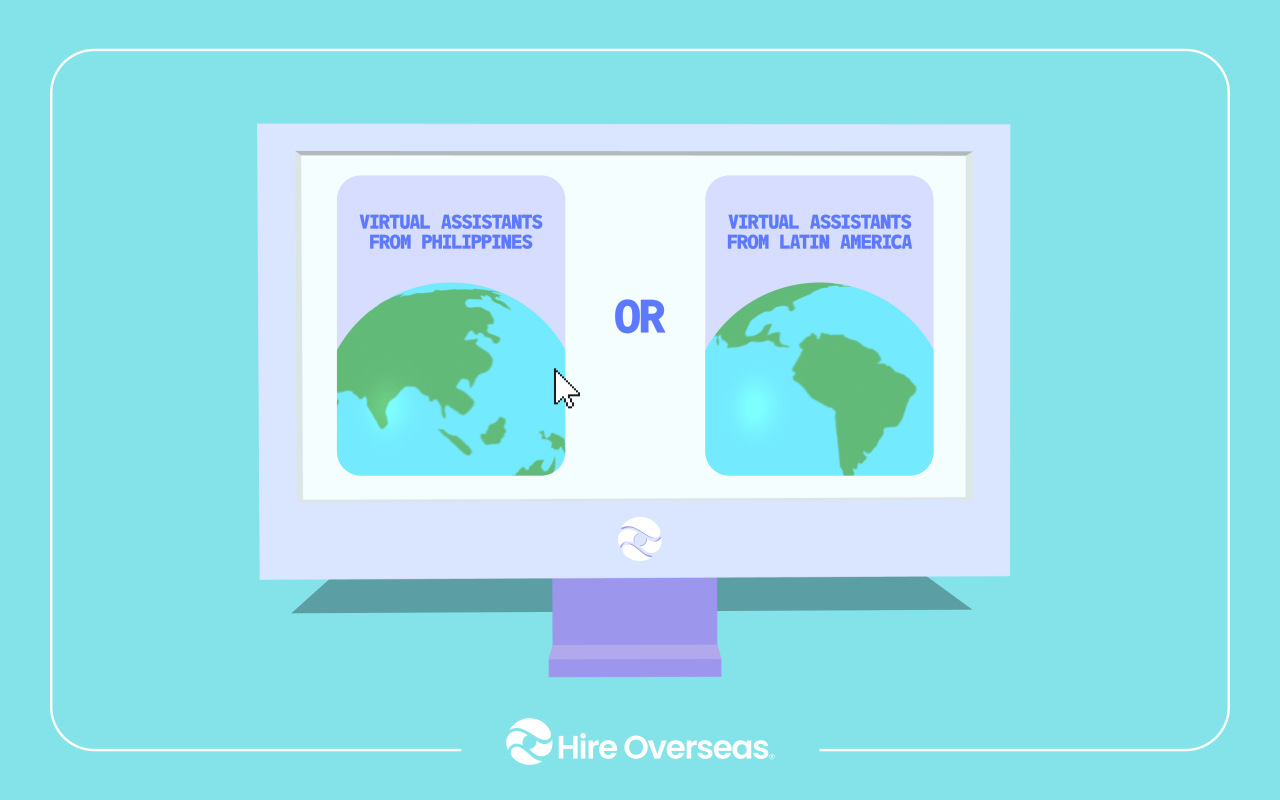A Complete Guide to Hiring Your First Remote Team in 2025

The global shift towards remote work, particularly in recent years, has been fueled by technological advances and a burgeoning work culture that favors more flexible arrangements. It is estimated that by 2026, nearly 70% of the worldwide workforce is expected to indulge in operations that are at least partially remote, demonstrating just how deeply embedded the practice has become in modern business.
Outsourcing is fundamentally about delegating specific business functions or roles to external teams or agencies. Why do that? The practice has evolved, though, from a mere cost-saving bit of strategy to an essential component of contemporary strategic planning especially when businesses seek to become ever more agile and operationally efficient, and to find a broader array of talent.
This is a guide for startups, small to medium-sized businesses (SMBs), and entrepreneurs who are thinking about or are in the process of making their first remote hires. If your aim is to obtain specialized talent, to smoothly scale operations, or to amp up your competitiveness without a budget explosion, then a firm grasp of the first principles of remote workforce outsourcing will serve you well.
Outsourcing Basics
What Exactly Is Employee Outsourcing?

Employee outsourcing is the strategic use of external service providers to fill specific functions that are usually done in-house. It’s not quite the same as freelancing (although sometimes it seems pretty close), because an outsourced person is meant to be part of a structured, ongoing relationship. The person who is outsourced should be able to integrate closely into the business’s daily workflow.
Types of Outsourcing:
- Offshore Outsourcing involves hiring teams or individuals in distant countries, often to capitalize on lower labor costs and around-the-clock productivity.
- Nearshore Outsourcing means partnering with providers in neighboring or nearby countries, offering cost advantages while minimizing time-zone differences and cultural gaps.
- Onshore Outsourcing is contracting providers located within your own country, prioritizing seamless communication, cultural alignment, and easier compliance management.
Outsourcing vs. Hiring Freelancers:
Although both outsourcing and hiring freelancers deal with resources outside your organization, outsourcing is usually about fostering a long-term relationship in which the external resource becomes part of your internal team. Freelancers, on the other hand, are usually around only for the duration of a project. They work independently, don't integrate into your daily operations, and aren't part of the 24/7/365 internal team.
Why Businesses Outsource Employees

Access to Global Talent
You can now find specialists or skilled workers that might be in short supply or too expensive locally, in pools of talent all over the world. Outsourcing has done more than anything else to make the notion of a global economy real.
Cost-Efficiency and Financial Savings
It is quite common for companies to outsource in order to reduce operational costs and save a lot of money. The reason is simple: when looking to save, companies tend to look at where to spend less on labor. They seek regions where they can find lower-priced, yet still capable, labor. They seek to hire people in places with lower living costs so that the salaries, while still decent in those regions, are nothing compared to what we'd expect to see in a first-world country for the same kind of work.
Business Scalability and Flexibility:
Outsourcing allows for fast and responsive scaling, without the commitment or complexity of hiring permanent staff. It is a way to quickly staff operations—ramping them up or down based on demand. This makes it a vital option for today’s rapidly evolving market environment.
Common Myths and Misconceptions
Despite its benefits, outsourcing is often surrounded by misconceptions. Let’s clarify and address these directly:
Myth 1: Loss of Control and Quality
Numerous concerns about outsourcing revolve around issues of quality and control, especially for tasks deemed critical. Yet even as worries persist, the tools and techniques of modern project management are doing an increasingly good job of maintaining the appearance of quality and control.
Take, for instance, the project management software Jira. Developed by the Australian firm Atlassian, Jira is a tool of the software development trade.
Myth 2: Security and Data Risks
Outsourcing carries with it another significant concern—data security. But cloud-based tools, encryption that uses advanced algorithms, and strict (but not overly draconian) agreements with your vendors (like NDAs) reduce this risk to levels that, while not zero, are acceptably low.
Myth 3: Cultural and Communication Barriers
Cultural variations and communication hurdles might appear difficult at the start. Yet, when it comes to forming global teams, there’s good reason to believe that—by implementing certain strategies—leaders can ensure that all team members feel like they belong. What follows are methods used by effective leaders to ensure that cultural differences and communication gaps do not hinder team function.
It is essential for your business to understand these prevalent myths and how modern tools and strategic planning easily overcome them, so you can confidently leverage outsourcing without hesitation.
Choosing the Right Outsourcing Model for Your Business
Not all models of outsourcing are equal. Selecting the appropriate one depends upon your objectives, your level of acceptable risk, and your operational requirements. Here’s a rundown of the four predominant models:
Staff Augmentation
Most advantageous when you require rapid filling of skill gaps and short-term commitments. You control the day-to-day management of the operations while increasing or decreasing the size of your teams as necessary. Excellent fit for projects that are technical, in nature, for seasonal surges, or for minimum viable product (MVP) type of work.
Employer of Record (EOR)
Ideal for businesses that are growing into international markets. The EOR employs your global workforce legally and properly while you direct their daily tasks. It’s quick, low-risk global hiring. No local entity required.
Professional Employer Organization (PEO)
Most suitable for organizations with a legal presence seeking assistance with human resources. A professional employer organization co-employs your workforce and manages payroll, tax, and benefits administration, enabling you to concentrate on growth while avoiding compliance pitfalls.
Direct Contracting
When hiring specialists for unique, high-impact positions—think short-term or one-off deals—you can count on maximum flexibility and minimum overhead. Just remember that you're also taking on the compliance, legal risk, and tax handling that come with employing someone in this manner. Importantly, this route is also suitable for roles that involve trusted individuals.
Choosing the Right Fit
Use a simple decision matrix:
- Need for speed? → Employer of Record
- Have an entity but want HR off your plate? → Professional Employer Organization
- Need flexibility for a short-term build? → Staff Augmentiation
- Hiring a single expert you trust? → Direct Contracting
Choosing the right model early saves time, reduces risk, and sets your team up for long-term success.
Step-by-Step Guide to Hiring Your First Remote Team

A successful remote team starts with clear planning and precise execution. Here’s a streamlined, step-by-step approach:
Step 1: Identify Your Needs
Define exactly what roles you need, what skills they require, and whether the workload justifies full-time, part-time, or project-based support. Separate core functions that should remain in-house from tasks that can be reliably outsourced.
Step 2: Budget and Cost Analysis
Account for total costs—not just salary, but tools, onboarding, and oversight. Compare in-house vs. outsourced costs for the same output. Use ROI projections to validate that outsourcing improves margins or unlocks strategic value.
Step 3: Finding and Vetting Providers
Research agencies or platforms with strong domain experience. Shortlist based on client reviews, portfolio relevance, responsiveness, and transparent pricing. Always verify legal standing, data security policies, and operational maturity.
Step 4: Legal Considerations and Compliance
Draft airtight contracts covering IP ownership, confidentiality (NDAs), termination terms, and liability clauses. Research local labor laws to ensure compliant hiring—especially for tax, severance, and benefits. Use checklists to avoid regulatory blind spots.
Step 5: Onboarding and Training Remote Teams
Start with a structured onboarding process that introduces your company culture, tools, and expectations. Use collaborative platforms (Slack, Notion, Loom) to enable smooth knowledge transfer. Set clear KPIs from day one to align accountability.
A thoughtful setup reduces miscommunication, improves performance, and sets a strong foundation for long-term success.
Tools & Technology to Manage Remote Teams

Managing a remote team requires more than just hiring the right people, you need the right systems in place to keep everyone aligned, productive, and compliant. Here are the core tool categories every remote operation should prioritize:
Communication Platforms
Tools like Slack, Zoom, and Microsoft Teams are essential for keeping distributed teams connected. Slack enables fast, organized messaging and async collaboration. Zoom and Teams support real-time meetings, interviews, and team syncs—critical for maintaining visibility and building trust in remote environments.
Project & Task Management
Platforms such as Asana, Trello, and Jira make work transparent and trackable. Use Asana for marketing and cross-functional teams, Trello for visual workflows, and Jira for agile software development. These tools clarify ownership, reduce redundancy, and keep remote teams aligned to deadlines.
Productivity & Time Tracking
For visibility into work habits and output, tools like Hubstaff and Time Doctor offer real-time tracking, activity monitoring, and reporting. They’re particularly useful for hourly contracts, client billing, or identifying productivity trends across time zones.
HR, Payroll, and Compliance
Managing remote hires across borders is complex without tools like Deel, Remote, or BambooHR. Deel and Remote simplify global hiring, payroll, and tax compliance—allowing you to legally employ in 100+ countries without setting up local entities. BambooHR provides broader HR functionality like performance reviews, document management, and PTO tracking.
Measuring Performance and Ensuring Quality
Clear performance tracking is what separates effective remote teams from unreliable ones. Without metrics, quality control becomes guesswork.
Define Role-Specific Metrics
Start with measurable, outcome-based KPIs tied directly to each role’s business impact. For example:
- Developers: code quality, sprint velocity, issue resolution time
- Designers: revision count, delivery speed, stakeholder approval rates
- Customer Support: ticket resolution time, CSAT score, first response rate
Establish Regular Feedback Cycles
Implement structured reviews such as weekly check-ins for progress, monthly retrospectives for insights, and quarterly reviews for performance alignment. Consistent feedback builds accountability and improves retention.
Address Remote-Specific Challenges
Combat isolation, unclear expectations, and inconsistent output with proactive communication, documented workflows, and transparent goal-setting. Tools like Loom or Notion help clarify work without micromanaging.
Track Leading and Lagging Indicators
Balance productivity indicators (hours worked, tasks completed) with outcome indicators (business results, quality scores) to get a full picture of performance.
Clear KPIs, consistent feedback, and contextual tracking turn remote work from a challenge into a performance advantage.
[blog-cta_component]
Avoiding Pitfalls and Overcoming Challenges
Remote teams offer flexibility and scale but only if you proactively address the most common operational risks. Here’s how to navigate them effectively:
Handling Time Zone Differences
Overlap is more important than sameness. Design workflows that prioritize asynchronous communication, but schedule 2–3 hours of overlap for real-time alignment. Use tools like World Time Buddy or Clockwise to plan meetings and deadlines fairly across regions.
Set clear expectations for response windows and lead times. Document everything from decisions, updates, to next steps, to avoid blockers when team members are offline.
Managing Cultural Gaps and Building Cohesion

Cultural differences can lead to misunderstandings, but they also bring diverse perspectives. Promote shared rituals—like weekly team calls or informal “virtual coffees”—to humanize the team.
Use a shared communication playbook to standardize tone, feedback styles, and decision-making protocols. When in doubt, over-communicate with context.
Encourage local ownership of tasks while aligning everyone to a common mission and values. Cohesion comes from clarity and inclusion, not proximity.
Avoiding Legal and Compliance Errors
Misclassifying employees as contractors or ignoring local tax rules can lead to serious penalties. Use EORs or global payroll platforms (like Deel or Remote) when hiring in unfamiliar jurisdictions.
Always have signed contracts that address intellectual property, NDAs, termination, and liability. Consult local counsel if operating outside a vendor’s default support region.
Keep a compliance checklist for each country you hire in including labor laws, benefits requirements, and holiday policies.
Expert Insights and Best Practices
Seasoned operators in outsourcing and remote work emphasize one thing: success hinges less on geography, and more on process, trust, and culture. Here’s what they’ve learned and how you can apply it.
1. Think like a product team.
— Wade Foster, CEO of Zapier**
Wade built a 100% remote company with over 700 employees across 30+ countries. His approach: treat internal operations like product features—document everything, automate what you can, and iterate fast. Zapier’s success shows that remote teams thrive when communication and processes are intentional.
Takeaway: Document onboarding, workflows, and decision-making so outsourced teams don’t rely on tribal knowledge.
2. Focus on outcomes, not hours.
— Darren Murph, Head of Remote at GitLab**
GitLab, one of the largest all-remote companies globally, tracks performance based on output—not activity. Instead of micromanaging hours, they align every role to measurable KPIs. This fosters accountability and autonomy, especially in outsourced roles.
Takeaway: Replace time tracking with goal tracking. Use OKRs or role-specific KPIs to measure success.
3. Culture doesn’t happen by accident.
— Hailley Griffis, Head of Communications at Buffer**
Buffer invests in remote culture through transparency, personal check-ins, and regular virtual gatherings. They openly share salaries, growth plans, and retrospectives. This builds trust across borders and time zones.
Takeaway: Schedule informal touchpoints, share internal wins publicly, and make company values part of daily work.
4. Case Study: Doist – Long-Term Global Collaboration
Doist (makers of Todoist) has operated as a fully remote, asynchronous team across 30+ countries for over a decade. Their key practice? Deep onboarding, clear documentation, and a high writing culture. Outsourced and core contributors follow the same playbook.
Takeaway: Treat outsourced workers like core team members. Give them the same resources, training, and context.
5. Great vendors are strategic partners.
— Laurel Farrer, Founder, Distribute Consulting**
According to Laurel, companies that see outsourcing as transactional limit their growth. Strategic outsourcing involves long-term planning, shared goals, and clear mutual expectations.
Takeaway: Don’t just look for the cheapest vendor. Look for cultural fit, domain expertise, and strategic alignment.
By learning from these leaders and companies, you can build remote teams that aren’t just functional—but deeply aligned, scalable, and resilient.
Your First Remote Team Is Closer Than You Think
Outsourcing is no longer just a cost-cutting tactic, it’s a growth lever. With the right strategy, you can access global talent, move faster than competitors, and build a flexible team that scales with your business.
But success doesn't happen by accident. It requires:
- Clarity in roles and outcomes before hiring
- The right outsourcing model that fits your operational needs
- Tools and systems to keep distributed teams aligned and productive
- Clear performance metrics to ensure quality doesn’t drop
- Proactive management of timezone, culture, legal, and security challenges
- A long-term mindset, treating vendors and remote workers as strategic partners
Whether you're hiring your first remote developer, building an offshore support team, or exploring global expansion through an Employer of Record, the principles in this guide will help you do it right.
The companies winning in today’s market aren’t the biggest, they’re the most adaptable. Outsourcing gives you that edge.
Unlock Global Talent with Ease
Hire Overseas streamlines your hiring process from start to finish, connecting you with top global talent.




